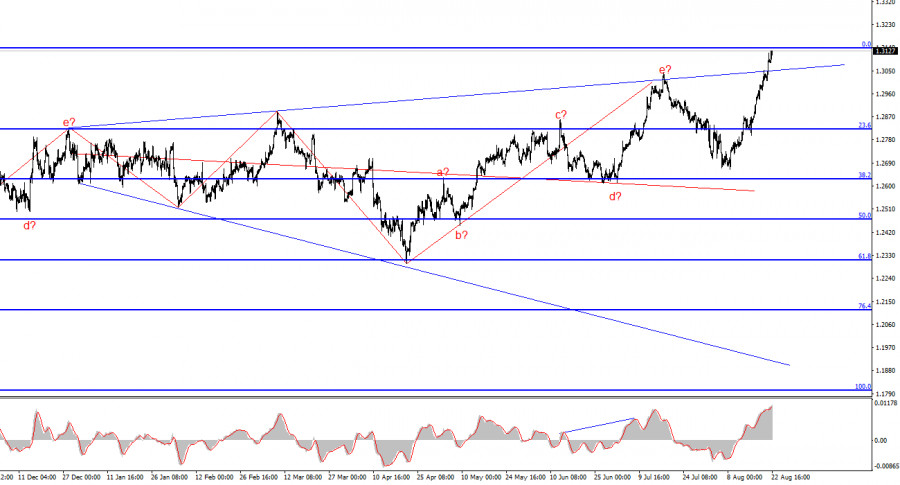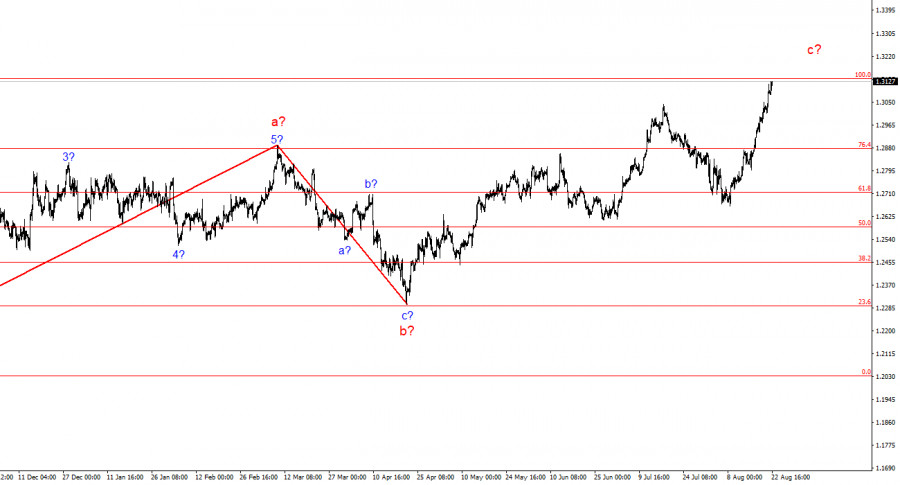

The wave pattern for the GBP/USD pair remains rather complex and ambiguous. For a while, the wave pattern appeared fairly clear, suggesting the formation of a downward set of waves targeting levels below 1.2300. However, in practice, demand for the U.S. dollar grew too strong for this scenario to materialize.
At present, the wave pattern has become difficult to interpret. I usually aim to use simple structures in my analysis because complex ones often have too many nuances and ambiguities. Currently, we observe an upward wave that has overlapped a downward wave, which in turn overlapped the previous upward wave, and so on—all within a triangle. The only assumption that can be made is the formation of an expanding triangle, with the upper point around the 1.3000 level and the balancing line around the 1.2600 level. However, the latest upward wave, which does not fit into any wave pattern, has pushed the quotes above the triangle. A three-wave corrective structure has yet to form.
Business Activity in the UK is Improving.
The GBP/USD exchange rate increased by another 20 basis points on Thursday, following a 60-point gain the previous day. This indicates that the demand for the British currency continues to grow. Today, the U.S. dollar once again had no chance of strengthening. Earlier in the day, UK business activity reports came in better than market expectations, and just half an hour ago, U.S. business activity indices were released, which did not provide clear support for the dollar. Business activity in the U.S. services sector rose from 55.0 to 55.2, which seems quite good, but manufacturing activity declined in August from 49.6 to 48.0. The decline in the latter was more significant than the growth in the former, so these reports collectively can be considered a negative for the dollar.
Furthermore, yesterday's FOMC minutes and the annual Nonfarm Payrolls report triggered a new decline in the U.S. currency. The minutes revealed that "many FOMC members" support a rate cut in September—not all, but many. While the exact number of "many" is unclear, it is likely more than half. In my view, a rate cut in September is still not certain, but as the saying goes, "there may be some basis to this expectation." The Nonfarm Payrolls report once again surprised no one with a weaker-than-expected figure, leading to a further decrease in demand for the U.S. currency. Tomorrow, Jerome Powell will speak at the Jackson Hole symposium, and it is unlikely that we will hear any "hawkish" statements from the Fed Chair.

The wave pattern for GBP/USD continues to indicate a downward movement. If the upward trend started on April 22, it has now formed a five-wave structure. Therefore, at the very least, a three-wave correction should now be expected. In my opinion, in the near future, it is worth considering selling the instrument with targets around the 1.2627 level, which corresponds to 38.2% on the Fibonacci retracement, and lower. However, a clear signal is now needed to initiate sell orders. With the current growth of the instrument, the wait for this signal could be long.
On a higher wave scale, the wave pattern has evolved. We can now anticipate the formation of a complex and extended upward corrective structure. At the moment, this is a three-wave pattern, but it could develop into a five-wave structure, which could take several months or more to complete.
Key Principles of My Analysis:
Wave structures should be simple and understandable. Complex structures are difficult to trade and often undergo changes.If there is no confidence in what is happening in the market, it's better not to enter it.There is never 100% certainty in the direction of movement. Always remember to use protective Stop Loss orders.Wave analysis can be combined with other types of analysis and trading strategies.